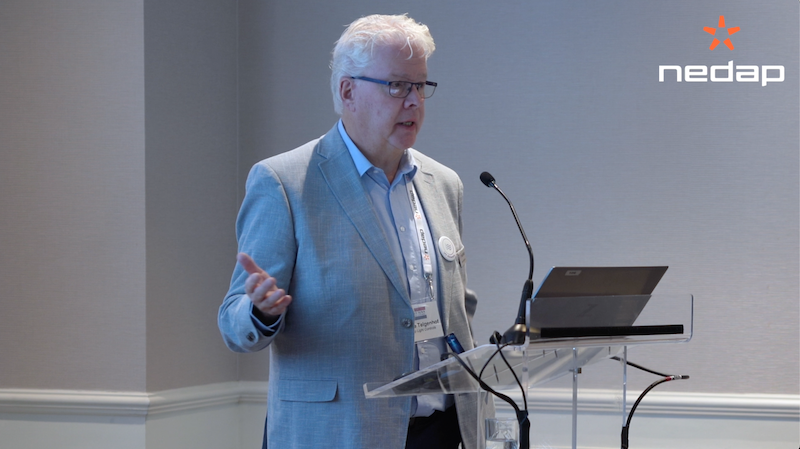Impact of energizing waveform on UV efficiency of low-pressure UV lamps
During the IUVA World conference, Tonnie Telgenhof Oude Koehorst (Nedap) hosted a session on how energizing waveform impacts the UV efficiency of low-pressure UV lamps.
The IUVA conference brings together experts and innovators from around the globe to exchange knowledge on UV technology. We’re proud to contribute to this conversation and to keep pushing the boundaries of sustainable UV solutions.
Main take-aways
The UV efficiency can still be improved.
Driving lamp current frequency is critical and has substantial impact on UV-C output.
Harmonics in the driving current of driver and lamp, will reduce overall (UV) efficiency.
Cable lengths affect the efficiency of the overall system, with 30 meters max as a rule of thumb (depending on lamp/cable type).
Optimizing all elements of the power supply – from power line, driver, lamp cable to waveform/frequency – can result in energy savings of 11 to 23%.
Optimizing UV performance of low-pressure UV lamps
Low-pressure (LP) amalgam lamps are currently the primary source of UV-C light used in water and air disinfection systems. Globally, the number of UV-C lamps installed in disinfection units is in the millions. This widespread deployment underscores the importance of optimizing every component in these systems for energy efficiency.
Lamp-type UV sources nowadays show UV efficiencies between 11% and 40% (low-, medium pressure and DBD lamps). UVC LEDs are nowadays up to 7,5% but still a far way to go before reaching same (35 to 40%) UV efficiency, especially for large scale industrial and municipal water treatment plants.
Also for low-pressure UV lamps, now available up to 1000W, there is still improvement possible in UV efficiency by energizing the lamp in the right way.

Operation of low-pressure mercury lamps
During ignition and the initial warm-up phase, a low-pressure mercury lamp rapidly increases its UV-C radiant flux until it reaches the maximum output level. After this point, the effective efficiency declines as a function of several operational and physical parameters, including:
- Lamp temperature – influences mercury vapor pressure and optimal discharge conditions.
- Lamp current – affects plasma stability and electrode loading.
- Operating frequency – determines discharge dynamics and power transfer efficiency.
- Waveform characteristics – deviations from optimized drive waveforms reduce conversion efficiency.
- Lamp lifetime (aging effects) – electrode degradation, mercury consumption, and coating deterioration progressively reduce UV-C output.
So, there is one key shared parameter between lamp and power supply that still offers room for improvement in UV-C output: the shape and frequency of the electrical current.

Frequency dependence of UV-C Efficiency
The relationship between UV-C efficiency and frequency in LP lamps was extensively studied in the 1960s through both experimental and theoretical work (Chr. Meyer, 1989). The resulting theoretical models aligned well with experimental data and helped establish the foundation for the design of modern electronic drivers.
Frequency spectrum of plasma current in an LP lamp can be divided into four characteristic regions:
TD: Time constant of ambipolar diffusion. In this low-frequency range, the discharge behaves like a slowly varying DC discharge.
THg: Lifetime of excited mercury atoms. In this intermediate range, frequency modulation affects the electron temperature, resulting in reduced UVC output compared to DC.
This range yields the maximum electron temperature, enhancing mercury atom excitation and maximizing UVC emission.
Te: Relaxation time of electron energy. At very high frequencies, discharge parameters (e.g. electron temperature, concentration) remain constant, similar to DC behavior.
Where ω=2πf and f is the frequency of the energizing lamp voltage/current.
These frequency ranges show that changing the current frequency—while keeping input power constant—can either increase or decrease UV-C output.
Implications for electronic power supplies
Most commonly used electronic drivers operate in the optimal frequency range 3 (1/tHg << ω << 1/te), typically between 30 and 60 kHz. However, their output current waveform is not a pure sine wave—it contains harmonics. These harmonics often fall outside the optimal region and into range 4, which corresponds to discharge conditions similar to DC operation.
As a result, these harmonics do not contribute to increased UV-C output, and thus reduce the overall efficiency of the system.

Conclusion
While UV-C lamp and driver efficiency has plateaued in terms of traditional optimization, current waveform design and frequency control present a critical remaining lever for improving UV-C output. Designing power supplies that maximize operation within the optimal frequency window – and minimize harmonic distortion – can lead to meaningful gains in energy efficiency and disinfection performance.
Want to see how waveform optimization can boost your system’s efficiency? Get in touch with our experts and discover how Nedap’s smart drivers help you reduce energy use and optimize UV performance.


